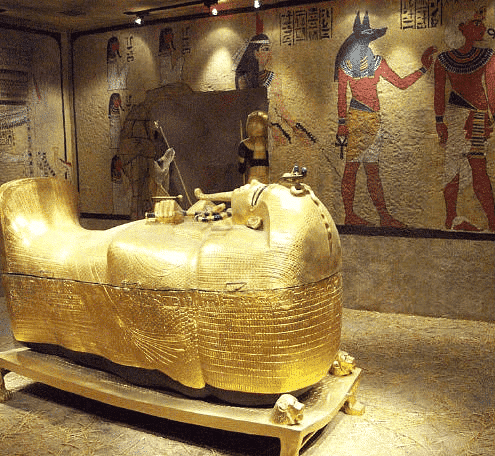Discovering Tut : The Saga Continues Class 11 English Hornbill
| Table of contents |

|
| Key Points of the Story |

|
| Detailed Summary |

|
| Conclusion |

|
| Theme |

|
| Message |

|
| Difficult Words |

|
Key Points of the Story
- "Discovering Tut: The Saga Continues" by A.R. Williams delves into the fascinating life, death, and legacy of King Tutankhamun, popularly known as the Boy King of ancient Egypt.
- The story explores the discovery of his tomb, the treasures buried with him, and the enduring mysteries surrounding his untimely death at the age of about 19.
- Modern technology like CT scans has enabled researchers to investigate the remains of King Tut without causing damage, providing new insights into his life and death.
- Howard Carter’s 1922 discovery of Tut’s tomb revolutionized archaeology but also highlighted the reckless methods of the time, which caused damage to the mummy.
- The narrative reflects on ancient Egyptian burial practices, the grandeur of Tut’s funerary treasures, and the shift in archaeology from treasure hunting to the scientific study of history.

Detailed Summary
Introduction
The story begins with the removal of King Tut’s body from his tomb in the Valley of the Kings on January 5, 2005, for a CT scan to investigate lingering mysteries surrounding his life and death. Known as the Boy King, Tutankhamun was the last ruler of a powerful dynasty that reigned during ancient Egypt’s New Kingdom period over 3,300 years ago.
Howard Carter’s Discovery
In 1922, Howard Carter, a British archaeologist, discovered Tut’s nearly intact tomb after years of fruitless searching. The tomb’s treasures, including gold artifacts, jewelry, and everyday items, created a sensation worldwide. However, Carter’s methods, though groundbreaking for the time, were invasive. To extract the mummy from its solid gold coffin, Carter had to chisel away hardened resins, inadvertently damaging the body. His actions sparked criticism in later years, as archaeology evolved into a more cautious and scientific discipline.
Tutankhamun’s Legacy
King Tutankhamun ascended the throne as a young boy and ruled for about nine years. His father, Amenhotep IV (Akhenaten), had introduced radical religious reforms, including monotheism focused on worshiping Aten, the sun disk. After Akhenaten’s death, Tutankhamun restored traditional religious practices, reinstating the worship of Amun and other deities.
Theories About His Death
King Tut’s death has been the subject of much speculation, ranging from illness to murder. As the last heir of his family, his unexpected death marked the end of a dynasty. The cause of his death remains a mystery, with theories suggesting a chariot accident, a fatal wound, or genetic complications due to inbreeding.
Advancements in Archaeology
The story highlights the role of modern tools like CT scans in uncovering details about ancient remains. In 2005, a portable CT scanner was used to create 1,700 cross-sectional images of King Tut’s body, providing intricate details about his bones, rib cage, and skull. Although the exact cause of death remains unclear, the scans revealed significant physical details that enhance our understanding of his life and burial.
Funerary Treasures and Burial Practices
Tutankhamun’s tomb was filled with treasures, including golden masks, jewelry, ceremonial items, and everyday goods like food and clothing. These items reflect the ancient Egyptian belief in an afterlife where the dead would need such possessions. Tut’s burial was also unusual due to the hastily performed rituals, possibly indicating his sudden death.
The Curse of the Pharaoh
The story touches on the popular myth of the pharaoh’s curse, which suggests that those who disturb a tomb will face misfortune or death. Although this is likely a coincidence, it adds to the intrigue surrounding Tutankhamun’s story.
Significance of the CT Scan
The CT scan marked a significant shift in archaeology, moving from treasure hunting to a focus on understanding historical and cultural contexts. Tut’s scan was the first in a series of investigations under the Egyptian Mummy Project, which aims to study ancient mummies using non-invasive techniques.
Conclusion
"Discovering Tut: The Saga Continues" bridges the gap between the past and present, using modern technology to explore ancient mysteries. It portrays King Tutankhamun as a symbol of both grandeur and tragedy, whose untimely death left unanswered questions that continue to intrigue scholars and the public alike. The story emphasizes the evolution of archaeology, showcasing how scientific advancements have transformed our understanding of history while advocating for the preservation of cultural heritage.
Theme
The central theme of the story is the intersection of history, science, and mystery. It reflects on the cultural richness of ancient Egypt, the advancements in archaeological methods, and the enduring human curiosity to uncover the secrets of the past.
Message
The story conveys the importance of combining scientific exploration with respect for historical artifacts. It underscores that while technology can reveal new insights into the past, preserving cultural heritage and learning from history are equally vital.
Difficult Words
- Forensic Reconstruction: Rebuilding a physical likeness using scientific methods.
- Funerary Treasures: Valuables buried with a person for the afterlife.
- Scudded: Moved quickly across the surface.
- Casket Grey: A dark, gloomy shade resembling a coffin.
- Computed Tomography (CT): A medical imaging technique that creates detailed 3D images.
- Resurrection: Rising from the dead or being brought back to life.
- Circumvented: Avoided or bypassed.
- Severed: Cut off or removed forcibly.
- Eerie: Strange and frightening.
- Artifacts: Objects made by humans, typically of historical interest.
|
72 videos|449 docs|80 tests
|
FAQs on Discovering Tut : The Saga Continues Class 11 English Hornbill
| 1. What is the main focus of the story "Discovering Tut: The Saga Continues"? |  |
| 2. How did the discovery of Tutankhamun's tomb influence archaeology? |  |
| 3. What are some key artifacts found in Tutankhamun's tomb? |  |
| 4. What themes are explored in "Discovering Tut: The Saga Continues"? |  |
| 5. What message does "Discovering Tut: The Saga Continues" convey about the importance of history? |  |





















